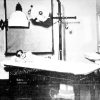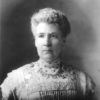calsfoundation@cals.org
Kate Turner House
The Kate Turner House was built in 1904 as a residence for James William Turner and his wife Kate Kelso Turner and is located at 709 West Main Street in Magnolia (Columbia County). The property was added to the National Register of Historic Places in 1982.
Kate Kearney Kelso was born in Magnolia on August 16, 1871. She married merchant James William Turner on March 12, 1899, in Columbia County. Her family members were among the earliest residents of the area and became prominent Magnolia citizens. Her father was an attorney in Magnolia, and her grandfather, Milton Garrison Kelso, was the surveyor of the original one-mile square plat of the city of Magnolia, modeling it after the city square in Oxford, Mississippi.
The home was built on land deeded to Kate Turner by her father, John Milton Kelso. Her husband James Turner was the owner of Turner Hardware, which, at one time, was located on the northwest corner of West Main and Jefferson on the Magnolia city square but had moved to another location by 1903, following a fire. After her husband’s death from tuberculosis in 1921, Kate retained ownership of the hardware business and continued to live in the house until she died in 1953. The couple had no children.
The National Register of Historic Places registration form lists the Kate Turner House builder/architect as Sidney and Stewart—an apparent error, as it was most likely Sidney Stewart, a prominent architect based in Texarkana (Miller County) at the time. Stewart was an associate of architect Eugene Charles Siebert, who designed the Dr. H. A. Longino House at 317 W. Main Street, also in Magnolia. Among other structures in southwestern Arkansas Stewart designed are the First Presbyterian Church in Texarkana, the Little River County Courthouse in Ashdown, and a two-story brick school building in Nashville (Howard County).
The design of the home’s north elevation combines elements of the Queen Anne and Colonial Revival styles with elements in keeping with late Victorian tastes. The northwest corner of the façade features a projecting chamfered bay with overhanging cross gable. The first and second floors have large rectangular double-hung windows. The gable has a single leaded-glass window with a deep cornice and cornice molding. The northeast corner has a turret-like semi-circular bay with three rectangular double-hung windows and a round bell-shaped roof. There is a one-story flat-roofed porch that wraps around the building that follows the curve of the northeast bay and is supported by round columns. The original wood porch was converted to concrete with semi-circular concrete steps circa 1920. The steps lead to the front door, which has an oval glass light with transom that opens to the dining room. On the east elevation, the porch projects forward at a ninety-degree angle. Concrete steps lead to a single door with a rectangular light and transom flanked by side lights. This elevation has a steeply pitched hip roof with a single gable-roofed dormer including an arched double-hung window with overlapping wood shingle siding.
Around 1918, a one-story flat-roofed addition faced with overlapping weatherboard was built on the south side of the east elevation. The addition has three rectangular double-hung windows placed side by side. A single door with a large oval, beveled glass light leads from the porch to the addition.
The south and west elevations are somewhat plain compared to the rest of the house. The west façade projects with a hip-roofed arm of the house that is lower than the north elevation. The second floor of this elevation has two rectangular casement windows. This elevation includes a one-story shed-roofed porch and a narrow one-story hip-roofed storage room. In 1922, a maid’s quarters originally located elsewhere on the property was attached to the southwest corner of the house. After this addition, the shed-roofed porch on the west side was enclosed. The south elevation has two one-story additions, with the hip roof and façade of the original 1904 building rising above and at the back of the additions.
The interior floorplan of the house is an asymmetrical Victorian-style with a large entrance foyer open to all the first-level rooms. A parlor and dining room are on the north side with a kitchen at the rear. The entrance foyer has a main stairway with attached fireplace. Upstairs, three bedrooms open off a central hall. Interior details are simple but are in keeping with Colonial Revival style.
The large corner lot was once covered with shade trees that were removed due to poor condition and age. The original wooden double-doored carriage house is still located at the far west rear of the property.
Donald M. Moody (1941–2009) moved into the home in the early 1970s, resided there for about thirty-five years, and was the owner when the property was added to the National Register of Historic Places on August 26, 1982. Rebecca Swofford bought the house in 2010 and undertook renovations and repairs.
For additional information:
Ford, Steve. “The Dream Home Rebecca Swofford Dared to Dream Really Did Come True.” Magnolia Reporter, February 13, 2023. https://www.magnoliareporter.com/news_and_business/local_news/article_65a8b7d4-aa80-11ed-9132-0b04ea145a2b.html (accessed August 13, 2025).
“Hon. J. M. Kelso.” Arkansas Gazette, October 4, 1894, p. 3.
“Kate Turner House.” National Register of Historic Places registration form. On file at Arkansas Historic Preservation Program, Little Rock, Arkansas. Online at https://www.arkansasheritage.com/arkansas-historic-preservation-program (accessed August 13, 2025).
Amy Staten McNeil
South Arkansas Heritage Museum
 Early Twentieth Century, 1901 through 1940
Early Twentieth Century, 1901 through 1940 Historic Preservation
Historic Preservation Kate Turner House
Kate Turner House 



Comments
No comments on this entry yet.